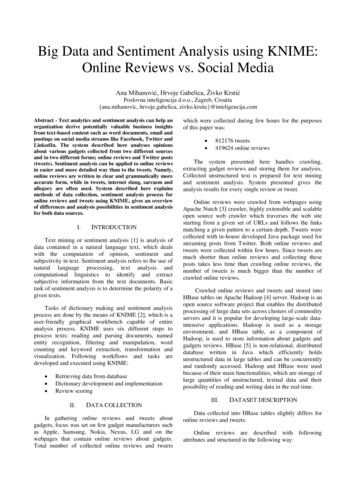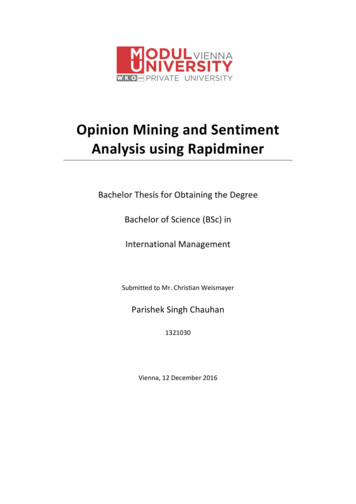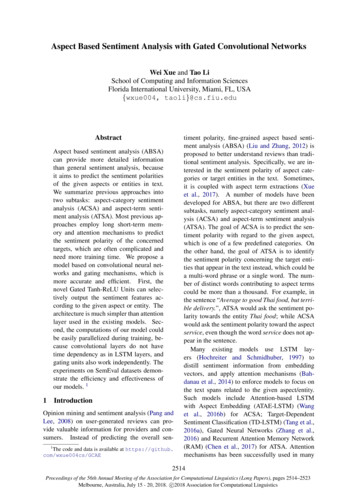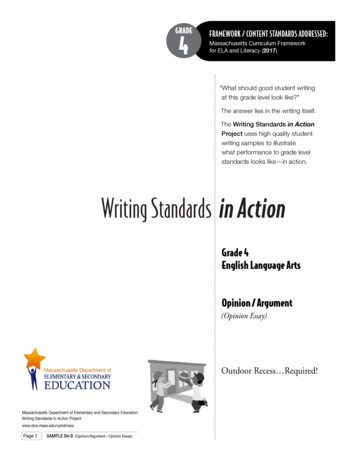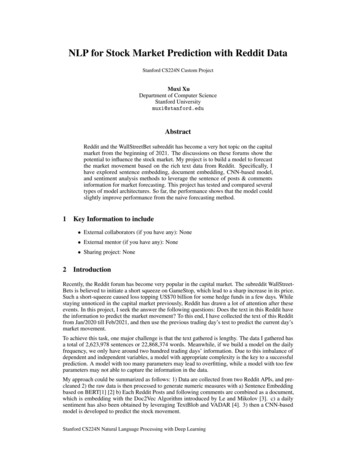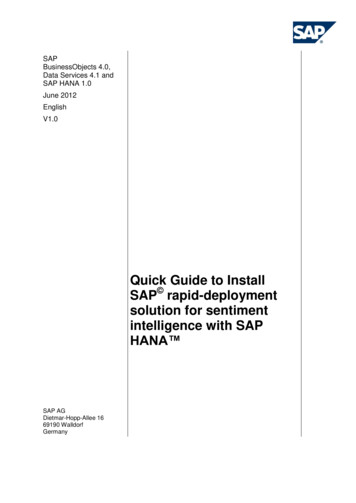
Transcription
University of Sheffield NLPSentiment Analysis(Opinion Mining)with Machine Learningin GATE
University of Sheffield NLPOutline What is sentiment analysis?Example: consumer reviewsUsing GATE ML for this problemBatch Learning configurationBuilding the application and trainingApplication and evaluationBuilt-in cross-validationSuggestions for further experiments
University of Sheffield NLPSentiment analysis Applications: business intelligence,opinion mining, reputation monitoring,etc. Several problems:– identifying opinionated segments of text– identifying the opinion-holder– classifying the opinion (positive, negative,degree)
University of Sheffield NLPSentiment analysis We will work on classifying theopinionated text using ML. We want to train a classifier to categorizefree text according to the training data.Good examples are consumers' reviewsof films, products, and suppliers.
University of Sheffield NLPExample: consumer reviews
University of Sheffield NLPExample: consumer reviews We have 40 documents containing 552company reviews. Each review has a 1to 5-star rating. We converted the HTML pages into GATEdocuments, preprocessed them to labeleach review with a comment annotationwith a rating feature, and saved them asGATE XML to make the corpus for thisexercise.
University of Sheffield NLPExample: consumer reviews
University of Sheffield NLPUsing GATE ML In ML terms:– instance comment annotation– class rating feature– attributes NLP features of the underlyingtext We will keep the spans of the commentannotations and use ML to classify themwith the rating feature
University of Sheffield NLPUsing GATE ML
University of Sheffield NLPBatch learning config We will start with the config file paum.xmlfrom the Module 11 materials. Copy this file to a writable directory, sincethe Batch Learning PR will need tocreate a savedFiles directory besideand write inside that.
University of Sheffield NLPBatch learning config PARAMETERname "thresholdProbabilityClassification"value "0.5"/ – For this example, this threshold willprobably produce a class for eachinstance– Classification problems do not use theother threshold probability parameters
University of Sheffield NLPBatch learning config multiClassification2Binary method "one-vs-others"/ – this is much faster than one-vs-another ENGINE nickname "PAUM"implementationName "PAUM"options " -p 50 -n 5 -optB 0.0 "/ – Perceptron with uneven margins– default options
University of Sheffield NLPBatch learning config INSTANCE-TYPE comment /INSTANCE-TYPE ATTRIBUTE NAME Class /NAME SEMTYPE NOMINAL /SEMTYPE TYPE comment /TYPE FEATURE rating /FEATURE POSITION 0 /POSITION CLASS/ /ATTRIBUTE Take comment annotations as instances, and classifythem using the rating feature. The classes (values of the rating features) form anundordered set (current limitation of the PR).
University of Sheffield NLPBatch learning config NGRAM NAME ngram /NAME NUMBER 1 /NUMBER CONSNUM 1 /CONSNUM CONS-1 TYPE Token /TYPE FEATURE root /FEATURE /CONS-1 /NGRAM Use unigrams of Token.root features inside the commentannotations as the instance attributes (bag of words). An additional feature in the hands-on file is commentedout for you to experiment with later.
University of Sheffield NLPBuilding the application Load the ANNIE, Tools, and Learningplugins. Create a new corpus called “training” andpopulate it from the directorycorpora/training in the Module 11hands-on material.
University of Sheffield NLPBuilding the application Create the following PRs with the defaultinit parameters:––––––Document Reset PRAnnotation Set TransferANNIE English TokeniserANNIE Sentence SplitterANNIE POS TaggerGATE Morphological Analyser
University of Sheffield NLPBuilding the application Create a Batch Learning PR with theconfigFileURL init parameter set to thepaum.xml file from the Module 11materials. Create a new Conditional Corpus Pipelineand show it.
University of Sheffield NLPBuilding the application Add the PRs to the pipeline as follows– Document Reset: setsToKeep “Key”– Annotation Set Transfer: annotationTypes [comment]copyAnnotations trueinputASName “Key”outputASName, tagASName,textTagName “”
University of Sheffield NLPBuilding the application Add more PRs to the pipeline–––––English tokeniserSentence splitterPOS taggerMorphological analyserBatch Learning: inputASName, outputASName “” learningMode TRAINING
University of Sheffield NLPTraining
University of Sheffield NLPTraining This pipeline will– leave the Key AS untouched,– copy the comment annotations to thedefault AS to provide the ML instancesand classes,– run the NLP components to provide MLinstance attributes, and– train the classifier.
University of Sheffield NLPTraining Run it on the training corpus (this shouldtake less than 1 minute) The classifier's model is stored in thesavedFiles directory beside thepaum.xml file. The model is stored intext files, but they are not meant to behuman-readable.
University of Sheffield NLPApplication Create a “testing” corpus and populate it fromthe corpora/testing directory. To apply the classifier, we need to havecomment annotations without rating features onthe default AS. These will give us the instancesto classify. A simple JAPE Transducer can dothis.
University of Sheffield NLPApplication Create a Jape Transducer from the filecopy comment spans.japein the Module 11 material. Insert the transducer in the pipeline after the ASTransfer PR. Set the transducer:– inputASName “Key”– outputASName “”
University of Sheffield NLPApplication Set the AS Transfer PR's run-mode to “no” Set the Batch Learning PR's parameters:– inputASName “”– learningMode APPLICATION– outputASName “Output” The classifier will get instances andattributes from the default AS and putinstances with classes in the Output AS.
University of Sheffield NLPApplication Set the pipeline to run on the testingcorpus, and run it. (This should alsotake less than a minute.)
University of Sheffield NLPApplication
University of Sheffield NLPApplication & evaluation Open a few documents and inspect theannotations:– Key.comment the users' ratings– default AS.comment the instances withno classes– Output.comment the instances with MLclasses
University of Sheffield NLPApplication & evaluation
University of Sheffield NLPApplication & evaluation Now show the testing corpus and click theCorpus Quality Assurance tab. Select––––Annotation Sets A Key, B OutputAnnotation Types commentAnnotation Features ratingF-Score F1.0-score strict Click “Compare”
University of Sheffield NLPApplication & evaluation If every instance has been classified, thenthe total P R F1, because everyspurious classification is paired with amissing classification Use the “Document statistics” sub-pane ofCorpus QA to confirm this, and to seehow specific documents were annotated
University of Sheffield NLPApplication & evaluation Now change the Measure to“Classification”, select Cohen's Kappa,and click “Compare”. In addition to the document statistics withsummary lines, there is now a“Confusion Matrices” sub-pane. Cells in these tables can be selected withthe mouse (or Ctrl-A to select all) andcopied with Ctrl-C, so you can pastethem in to a spreadsheet.
University of Sheffield NLPBuilt-in cross-validation Set the pipeline up almost the same wayas for training mode– Switch on the AS Transfer PR to copyKey.comment to the default AS– Switch off the JAPE transducer– but set the Batch Learning PR differently: inputAS, outputAS “” learningMode EVALUATION
University of Sheffield NLPBuilt-in cross-validation Create a new corpus “all” and populate itfrom the corpora/all directory (all thedocuments from training and testing.) Run the pipeline on the new corpus. Thiswill take a few minutes. This will carry out 5-fold cross-validationas specified in the config file.
University of Sheffield NLPBuilt-in cross-validation The config file includes:– EVALUATION method "kfold"runs "5" ratio "0.66" / – kfold ignores the ratio setting– holdout ignores the runs setting The Batch Learning PR will automatically split the corpusinto 5 parts, and then– train on 1,2,3,4; apply on 5; then– train on 1,2,3,5; apply on 4; – train on 2,3,4,5; apply on 1;– and average the results.
University of Sheffield NLPBuilt-in cross-validation Cross-validation is a standard way to “stretch”the validity of a manually annotated corpus.The 5-fold averaged result is more significantthan the result obtained by training on 80% ofthe same corpus and testing on 20% once. In GATE, you can't use the Corpus QA tool onthe result, but you get a detailed statisticalreport at the end, including P, R, & F1 for eachclass.
University of Sheffield NLPSuggestions forfurther experiments.
University of Sheffield NLPSuggestions. The config file URL is an init parameter,but the contents can be re-loaded, soyou can– use any text editor on the config file, savethe changes, and– re-initialize the Batch Learning PR to reload the file with changes.
University of Sheffield NLPSuggestions. Try n-grams where n 1– Change NUMBER in the config– Usually this is slower, but sometimes itimproves quality combining features– change CONSUM in the config to 2 anduncomment the Token.orth element– this concatenates the features
University of Sheffield NLPSuggestions. Adjust the thresholdProbabilityClassification– Increasing it may increase precision anddecrease recall, and may prevent theclassifier from assigning a class to everyinstance.– Decreasing it may increase recall anddecrease precision.– This is the “pickiness” control of the classifier.
University of Sheffield NLPSuggestions. Try using other features– Token.string, Token.category, or combinationsof these with Token.root and Token.orth You could even include other ANNIE PRs in thepipeline and use Lookup or other annotationtypes.– You need to run the same annotation-creatingPRs for training and application.– If the config file specifies an annotation that ismissing in an instance, the ML PR will throwan exception.
University of Sheffield NLP Built-in cross-validation Cross-validation is a standard way to “stretch” the validity of a manually annotated corpus. The 5-fold averaged result is more significant than the result obtained by training on 80% of the same corpus and testing on
